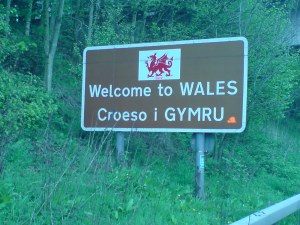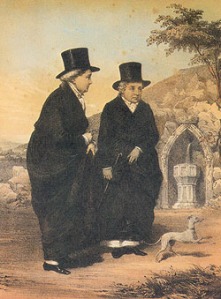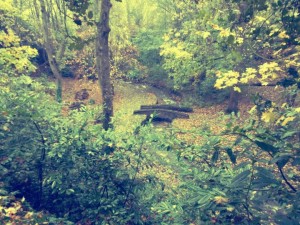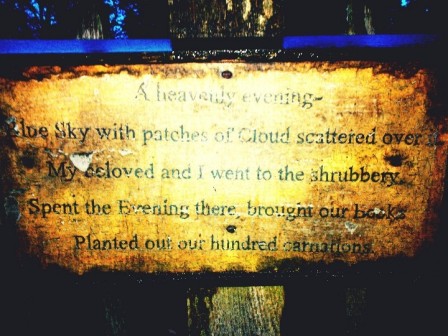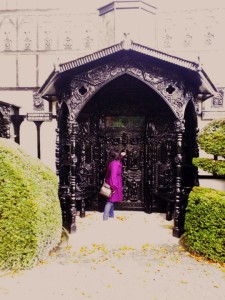I wasn’t so sure about Wales. I’ve been there a total of once in my life before this trip, and from what I remember, all things were written in Welsh and then English, but everyone talked with a Northern accent. So you walk around feeling like you’re in the middle of a weird documentary about remembering one of your past lives. Only… in this particular lifetime, you were the village idiot and you can’t pronounce place names so you ask everyone to just meet you near the local Tesco. It’s like you’re in a foreign country where everything seems vaguely familiar.
It’s only “down the road” from Chester, yet driving past the sign welcoming you to Wales is accompanied by a sense of achievement that you got this far and as a reward, great events now await to redefine your life. Still, the voice in my head says I should trust this reassuring feeling as much as I would the statement “We’ll be welcomed as liberators.” So, when I found out the exotic-sounding Welsh Rarebit is essentially cheese on toast, I have only myself to blame for ignoring the voice in my head as I bite into the delicacy that tasted a lot like disappointment.
I wonder if things felt as peculiarly adventurous to the aristocratic ladies, Lady Eleanor Butler (1739-1829) and the Hon. Sarah Ponsonby (1775-1831), when they arrived in the Welsh town of Llangollen to start their life together after eloping from Ireland, scandalizing their prominent families and 18th century society.
Eleanor was 39 and Sarah was 23 when they eloped. Their first attempt wasn’t successful, but they eventually managed to escape unwanted advances from guardians, forced marriages and the prospect of a life in a convent.
They had to rely on the allowance given to them by family members, but they were free to live their lives as they pleased. And what they pleased was to live in a house in the country, so that’s what they did. If they’d been men, they’d probably have just made the requisite improvements to their new pad and spent their days hunting, but these were ladies, so of course they transformed the cottage up on the hill into an architectural marvel, renamed it Plas Newydd (New Hall) and did some gardening.
Then as now, people were fascinated by their lifestyle. History books and contemporary accounts invariably describe their lifestyle as “eccentric,” and speculated on the nature of their relationship. They called each other “My Beloved” and “My Better Half”, habitually wore men’s clothing, had short hair and slept in the same bed. It wasn’t uncommon for people during that time to have “romantic friendships,” so no one can tell with absolute certainty if they had a sexual relationship or not, and this seems to be the main draw for people visiting them.
They were accepted in the village and were referred to as “the ladies,” but pretty soon they had celebrity status all over Britain. People such as Wordsworth, Byron, Lady Caroline Lamb, Percy Shelley, Sir Walter Scott, the Duke of Wellington, Anna Seward, and even the royal family became friends and visitors. They entertained daily, showing off their house and their devotion to each other. It wasn’t until last week, however, that they would have been able to say they had the great honor of having me there.
Having servants, fine wines, loads of books and constant house remodelling meant they were often in debt to maintain their lifestyle, which, to me, is a more “eccentric” aspect of their lives than whether or not they had sex with each other. Most of us (even some priests) have sex at some point in our lives, but these ladies had an allowance of £300 a year (more than most people could expect to have during that time) and still they managed to get into debt. It’s a common theme in aristocratic families, and considering these were the people who were expected to reign over the masses, you’d think the least they could do is learn to balance the books.
Sarah and Eleanor spent the rest of their lives together in Plas Newydd. They never did learn to budget during their more than 50 years together. The house is now run by the Denbighshire County Council, and people still go here to learn about them and be inspired because, whether they were in a lesbian relationship or not, it’s clear that these women managed to defy social convention and live their lives in a manner that few others in their lifetime could have imagined possible.
References:
http://www.youtube.com/watch?v=Vy7RZ8m2L3Y
http://ladiesofllangollen.wordpress.com
http://www.llangollen.com/plas.html
http://www.bbc.co.uk/blogs/wales/posts/ladies_of_llangollen
http://en.wikipedia.org/wiki/Ladies_of_Llangollen
http://womenshistorynetwork.org/blog/?tag=ladies-of-llangollen
